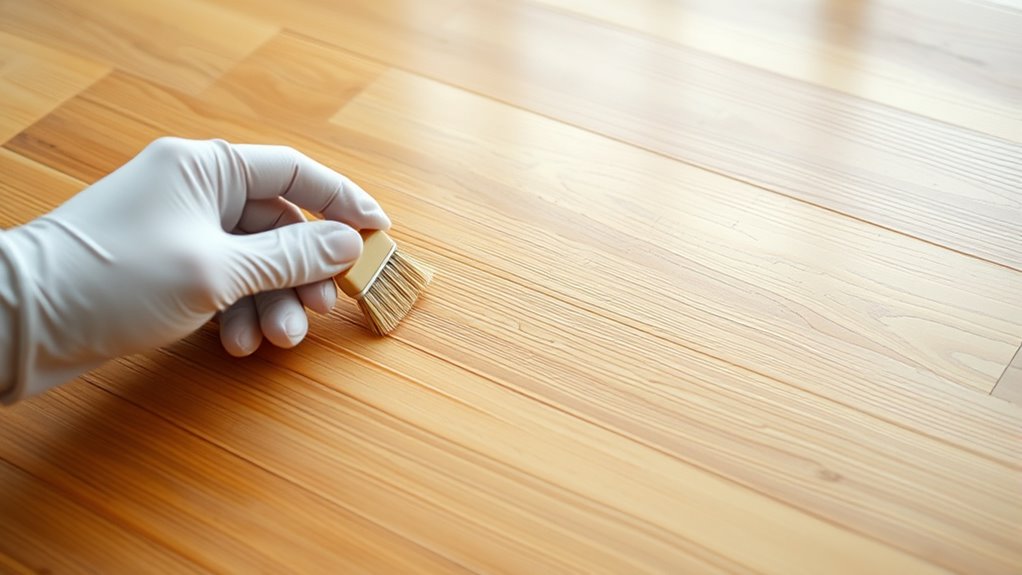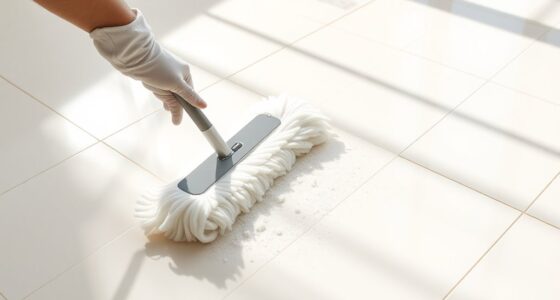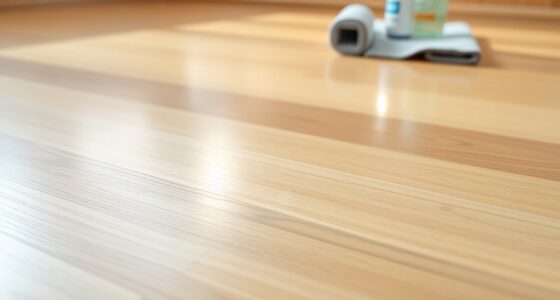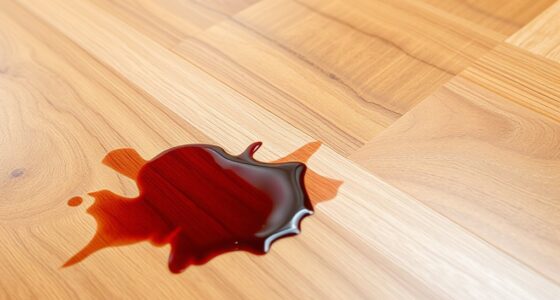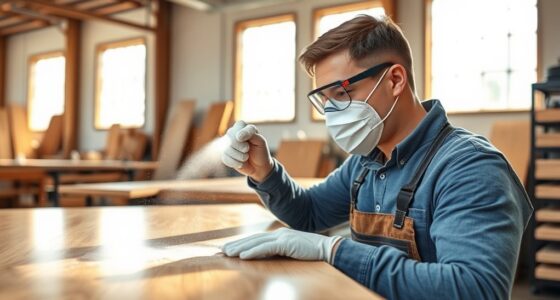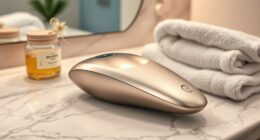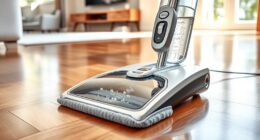Before you mop your bamboo floors, you need to remove all dirt, dust, and debris with a soft broom or vacuum to prevent scratches. Protect your furniture with felt pads and lift heavy pieces instead of dragging them across the surface. Use a damp, not soaking wet, microfiber mop along with a gentle, pH-balanced cleaner designed for bamboo. Staying proactive with these steps helps keep your floors smooth and scratch-free—discover more tips to preserve their quality.
Key Takeaways
- Sweep or vacuum thoroughly to remove loose dirt and debris before mopping.
- Use a soft broom or vacuum designed for hard floors to prevent scratching.
- Avoid using harsh chemicals or abrasive scrubbers that can damage the finish.
- Protect furniture legs with felt pads and lift objects instead of dragging.
- Apply a repair kit or touch-up stain to existing scratches prior to cleaning.
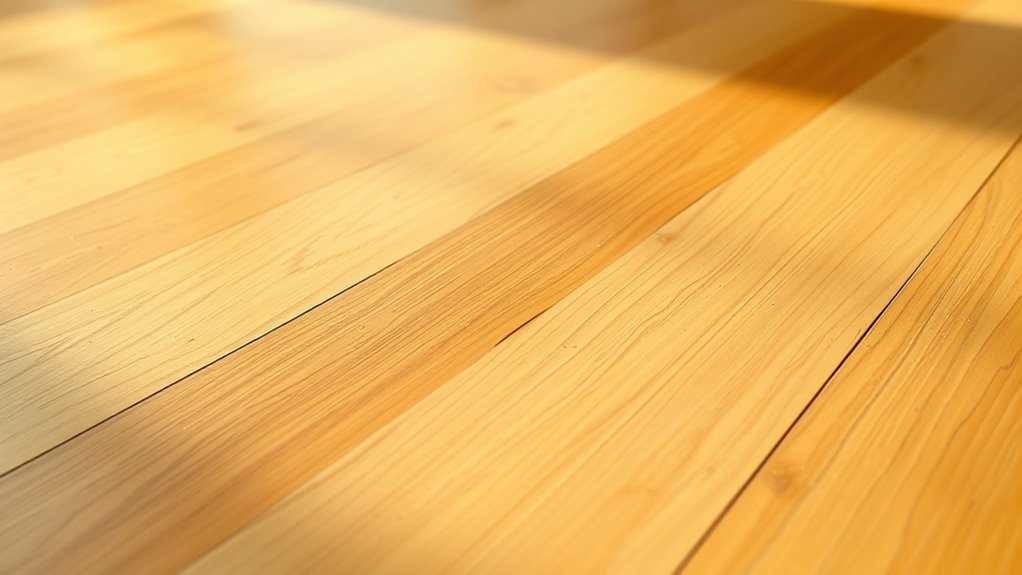
Have you noticed scratches marring your bamboo floors? If so, you’re probably wondering how to keep your floors looking pristine without causing further damage. The first step is understanding some essential cleaning tips that help prevent scratches from worsening. Before you even think about mopping, take a moment to remove loose dirt, dust, and debris with a soft broom or vacuum cleaner designed for hard floors. Dirt particles can act like tiny abrasives when you walk over them, scratching the surface each time. Regularly cleaning these off keeps your bamboo looking fresh and reduces the risk of scratches developing over time.
Regularly sweep or vacuum bamboo floors to prevent dirt from causing scratches.
When it comes to cleaning tips, always use a damp mop—not soaking wet—and a gentle, pH-balanced cleaner specifically formulated for bamboo or hardwood floors. Avoid harsh chemicals or abrasive scrubbers that can wear down the finish. Instead, opt for a microfiber cloth or mop that glides smoothly across the surface. Light, consistent cleaning prevents dirt buildup, which in turn minimizes the chance of scratches. Remember, never use steel wool or rough pads, as they can leave permanent marks. Additionally, ensuring proper airflow around the floor can help reduce moisture buildup that might weaken the finish or cause damage over time.
Furniture protection is equally important. Heavy or sharp furniture legs can easily scratch bamboo floors if they’re not protected. Placing felt pads or furniture coasters under the legs of chairs, tables, and other heavy pieces creates a buffer that absorbs the impact and prevents direct contact with the floor. When moving furniture, lift rather than drag it across the surface. This simple act can save you from deep gouges or scratches that are tough to repair. If you notice any existing scratches, consider applying a touch-up stain or a bamboo-specific repair kit to minimize their appearance and prevent further damage.
In addition, be cautious with rugs and mats. Use non-slip pads underneath to prevent sliding that could scratch the floor as furniture or people move around. Periodically check these pads for dirt or grit that might have accumulated and clean them accordingly. Keep pet nails trimmed to avoid accidental scratches when your furry friends run or jump across the floor. Combining these furniture protection strategies with proper cleaning routines creates a barrier against scratches, preserving your bamboo’s natural beauty. For added protection, consider using floor protectors, which can help distribute weight and reduce potential damage from heavy furniture.
Before you mop, always remember to sweep or vacuum first, and use cleaning tips that are gentle yet effective. Protecting your furniture and floor surfaces is the best way to maintain the elegance of your bamboo floors, keeping scratches at bay and ensuring they stay stunning for years to come. With a little effort and attention, you can enjoy beautifully maintained bamboo floors free from unsightly scratches.
Frequently Asked Questions
Can I Use a Steam Mop on Bamboo Floors?
You shouldn’t use a steam mop on bamboo floors because the high heat and moisture can damage the wood and cause warping. Instead, opt for gentle cleaning methods like steam cleaning with a damp cloth, but only if your bamboo floor is properly sealed. Floor sealing helps protect against moisture and scratches, making cleaning safer. Always check your floor’s sealant status before using any cleaning method, especially steam cleaning.
What Household Items Can Effectively Hide Scratches?
In an age where even a knight’s armor needs polishing, you can hide scratches with household items through DIY scratch repair. Use a walnut or almond to gently rub over minor scratches—natural oils help blend the mark. Furniture touch ups with a matching crayon, wood marker, or even a touch of coffee can conceal deeper scratches. These simple tricks make your bamboo floors look fresh without professional help.
How Often Should I Reapply Protective Finishes?
You should reapply the protective coating every 1 to 3 years, depending on foot traffic and wear. Keep in mind, the reapplication schedule varies based on how much use your bamboo floors get and the type of finish you select. Regularly inspecting the surface helps you determine when the protective coating needs a touch-up. Staying on top of the protective coating frequency ensures your floors stay durable and scratch-resistant longer.
Are There Eco-Friendly Cleaning Solutions Safe for Bamboo?
Yes, there are eco-friendly cleaners that are safe for bamboo floors. Look for bamboo-safe solutions labeled as eco-friendly or natural, as they avoid harsh chemicals. These cleaners typically use plant-based ingredients that gently clean without damaging the finish or the bamboo itself. Always read labels carefully, and test a small area first to verify compatibility. Using eco-friendly cleaners helps protect your floor and the environment at the same time.
How Do Temperature and Humidity Affect Bamboo Floor Scratches?
Temperature and humidity greatly impact bamboo floor scratches because climate affects moisture levels. When it’s too dry, bamboo becomes brittle and more prone to cracking and scratches. Excess humidity causes the bamboo to swell, leading to warping and surface damage. To prevent scratches, maintain consistent moisture levels and temperature, ideally around 60-80°F and 40-60% humidity. Proper climate control helps keep your bamboo floors smooth and durable.
Conclusion
To keep your bamboo floors beautiful and blemish-free, be proactive and prevent pesky scratches. Patience, prevention, and proper plying play a powerful part in protecting your prized planks. By brushing off dirt, using felt pads, and sweeping often, you’ll ward off wear and tear. Remember, your efforts guarantee your floors stay flawless, fabulous, and free from scratches. So, safeguard your space today, and step into a spotless, stunning sanctuary tomorrow!
